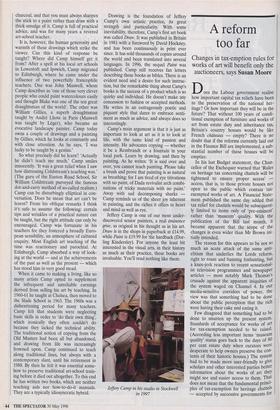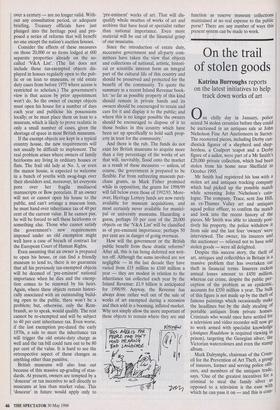A reform too far
Changes in tax-emption rules for works of art will benefit only the auctioneers, says Susan Moore
Does the Labour government realise how important capital tax reliefs have been to the preservation of the national her- itage? Or how important they will be in the future? That without 100 years of condi- tional exemption of furniture and works of art from estate duty and inheritance tax, Britain's country houses would be like French châteaux — empty? There is no doubt that if the reforms currently laid out in the Finance Bill are implemented, a sub- stantial number of these houses will be emptier.
In his last Budget statement, the Chan- cellor of the Exchequer warned that 'Rules on heritage tax concerning chattels will be tightened to ensure proper access' access, that is, to those private houses not open to the public which contain tax- exempted works of art. A Financial State- ment published the same day added that tax relief for chattels would be subsequent- ly limited to items only of 'pre-eminent' rather than 'museum' quality. With the publication of the Bill last month, it became apparent that the scope of the changes is even wider than Mr Brown ini- tially intended.
The reason for this appears to be not so much an acute attack of the same anti- elitism that underlies the Lords reform, right to roam and banning foxhunting, but a knee-jerk reaction to recent sensational- ist television programmes and newspaper articles — most notably Mark Thomas's crusade against the apparent iniquities of the system waged on Channel 4. In our media-sensitive corridors of power, the view was that something had to be done about the public perception that the rich were having their cake and eating it. Few disagreed that something had to be done to smarten up the present system. Standards of acceptance for works of art for tax-exemption needed to be raised. (According less important items 'museum quality' status goes back to the days of 80 per cent estate duty when curators were desperate to help owners preserve the con- tents of their historic houses.) The system had to. be made more user-friendly to give scholars and other interested parties better information about the works of art they might see and easier access to them. That does not mean that the fundamental princi- ples of tax-exemption for heritage chattels — accepted by successive governments for over a century — are no longer valid. With- out any consultation period, or adequate briefing, Treasury officials have just plunged into the heritage pool and pro- posed a series of reforms that will benefit no one except the nation's auction houses.
Consider the effects of these measures on those 20,000 or so items lodged at 600 separate properties already on the so- called 'V&A List'. (The list does not include those tax-exempted objects dis- played in houses regularly open to the pub- lic or on loan to museums, or old estate duty cases from before 1975 where access is restricted to scholars.) The government's view is that access by prior appointment won't do. So the owner of exempt objects must open his house for a number of days each year and publicise his possessions locally; or he must place them on loan to a museum, which is likely to prove realistic in only a small number of cases, given the shortage of space in most British museums.
If the exempt objects are kept in a typical country house, the new requirements will not usually be difficult to implement. The real problem arises where owners of family heirlooms are living in ordinary houses or flats. The frail old lady at No. 3, or even the manor house, is expected to welcome in a bunch of youths with swag-bags over their shoulders and, moreover, let everyone pore over her fragile mediaeval manuscripts or Bow porcelain. If an owner will not or cannot open his house to the public, and can't arrange a museum loan, he must hand over inheritance tax of 40 per cent of the current value. If he cannot pay, he will be forced to sell these heirlooms or something else. Those who cannot satisfy the government's new requirements imposed under an old exemption might well have a case of breach of contract for the European Court of Human Rights.
Even assuming that an owner is prepared to open his house, or can find a friendly museum to lend to, there is no guarantee that all his previously tax-exempted objects will be deemed of 'pre-eminent' national importance when he dies and the exemp- tion comes to be renewed by his heirs. Again, where these objects remain histori- cally associated with an outstanding build- ing open to the public, there won't be a problem; but, otherwise, only the Rem- brandt, so to speak, would qualify. The rest cannot be re-exempted and will be subject to 40 per cent inheritance tax. Even worse, if the last exemption pre-dated the early 1970s, a sale to meet the inheritance tax will trigger the old estate-duty charge as well and the tax bill could turn out to be 80 per cent of the value. It is hard to see the retrospective aspect of these changes as anything other than punitive.
British museums will also lose out because of this massive up-grading of stan- dards. At present, owners are tempted by a `clouceue or tax incentive to sell directly to museums at less than market value. This `clouceue in future would apply only to `pre-eminent' works of art. That will dis- qualify whole swathes of works of art and archives that have local or specialist rather than national importance. Even more material will be out of the financial grasp of our museums.
Since the introduction of estate duty, successive government and all-party com- mittees have taken the view that objects and collections of national, artistic, histori- cal or scientific interest form an integral part of the cultural life of this country and should be preserved and protected for the benefit of the community. To quote the summary in a recent Inland Revenue book- let: `so far as possible property of this kind should remain in private hands and its owners should be encouraged to retain and care for it and display it to the public; and where this is no longer possible the owners should be encouraged to dispose of it to those bodies in this country which have been set up specifically to hold such prop- erty in trust for the community.'
And there is the rub. The funds do not exist for British museums to acquire more than a tiny percentage of the works of art that will, inevitably, flood onto the market as a result of these measures — unless, of course, the government is prepared to be flexible. Far from unfreezing museum pur- chase grants, as Mark Fisher promised while in opposition, the grants for 1998/99 will fall below even those of 1992/93. More- over, Heritage Lottery funds are now rarely available for museum acquisitions, and most certainly never available for munici- pal or university museums. Hazarding a guess, perhaps 10 per cent of the 20,000 objects on the `V&A List' will be classified as of pre-eminent importance; perhaps 50 per cent are in danger of going overseas.
How will the government or the British public benefit from these drastic reforms? After all, this is tax being deferred not writ- ten off. Although the sums involved are not negligible — in the last decade they have varied from £15 million to £160 million a year — they are modest in relation to the inheritance tax collected each year by the Inland Revenue: £1.9 billion is anticipated for 1998/99. Anyway, the Revenue has always done rather well out of the sale of works of art exempted during a recession and then sold in a booming, inflated market. Why not simply allow the more important of these objects to remain where they are and function as reserve museum collections maintained at no real expense to the public purse? There are any number of ways this present system can be made to work.



































































 Previous page
Previous page